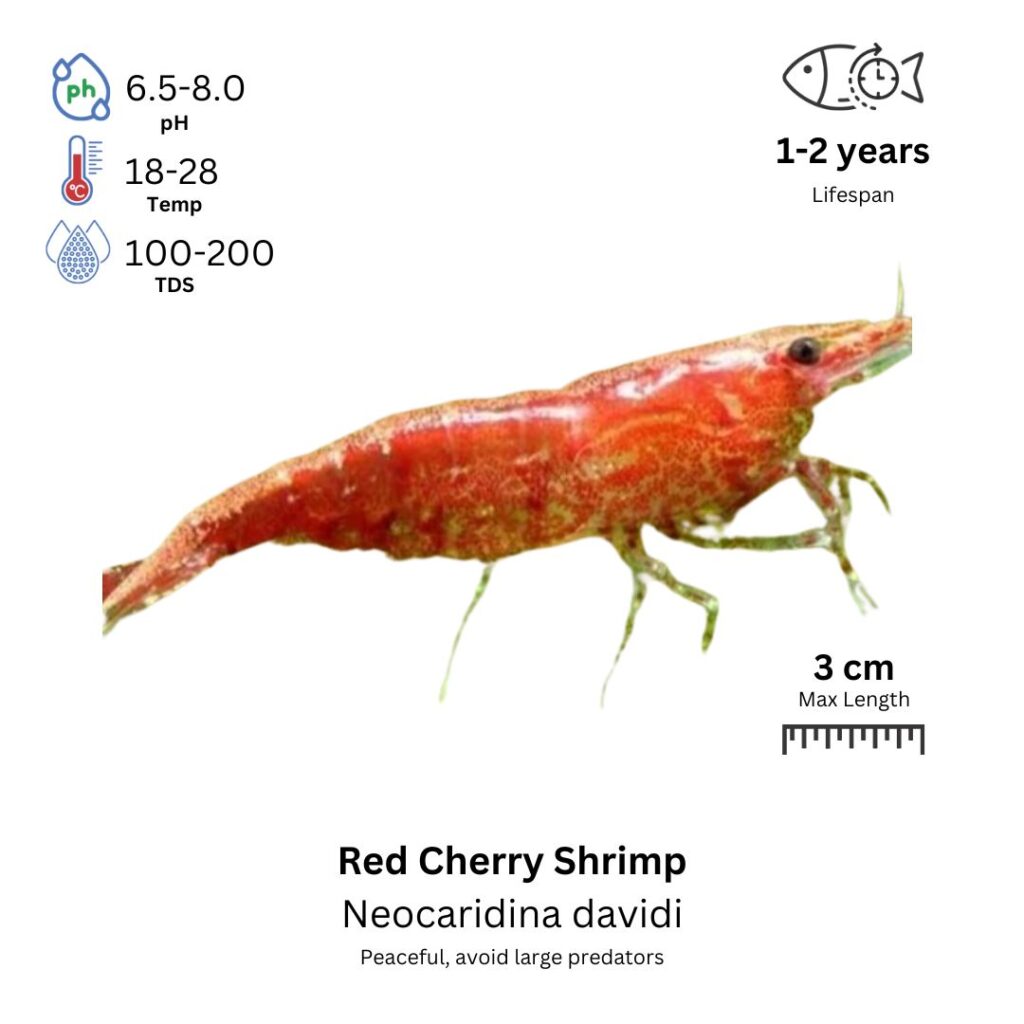Red Cherry Shrimp
Neocaridina davidi

Description
The Red Cherry Shrimp is a small, brightly colored freshwater shrimp with a translucent red body, ranging from deep red to lighter hues depending on the strain and the environment. These shrimp are known for their peaceful nature and small size, making them ideal for nano aquariums. They are active scavengers and will frequently be seen foraging on the substrate, plants, and aquarium surfaces. They are great algae eaters and help keep the tank clean.
Natural Habitat
Native to Taiwan, but now found in many aquariums worldwide.
Akuarium
Ideal Number in Aquarium: 10 or more to allow for natural behavior and breeding. They are social and do best in groups.
Favorite Foods

Primarily algae, biofilm, and detritus. They also enjoy small amounts of shrimp pellets, blanched vegetables like spinach or zucchini, and specialized shrimp food. Providing variety in their diet helps keep them healthy.
Behavior:
Red Cherry Shrimp are peaceful, non-aggressive, and ideal for community tanks. They spend most of their time scavenging the aquarium for food and interacting with each other. They are excellent at cleaning algae and leftover food. Their calm nature makes them compatible with most other peaceful tankmates, though they may be intimidated by larger or more aggressive species.
Special Care:
These shrimp are relatively hardy, but they do require stable water parameters to thrive. They can be sensitive to copper, which is toxic to invertebrates, so make sure no copper-based medications are used in the tank. Providing hiding spots, such as plants, rocks, or shrimp tubes, will help them feel secure.
Compatibility with Other Fish:
Yes, they are compatible with many peaceful species, including small fish, other shrimp, and snails. Avoid keeping them with larger or aggressive fish that may see them as food. Also, other shrimp species can be kept together, but crossbreeding may occur.
Breeding Tank Setup
Red Cherry Shrimp can breed in community tanks, but a dedicated breeding tank provides better control over water conditions and increases fry survival rates. A 10-gallon (38-liter) tank is ideal for maintaining a breeding colony. These shrimp thrive in slightly alkaline water with a pH of 6.5–7.5, a temperature range of 22°C to 28°C, and soft to medium-hard water (4–8 dGH). Filtration should be gentle—sponge filters are ideal because they offer biological filtration and aeration while being safe for baby shrimp. Use fine gravel or sand as a substrate, and include live plants like Java moss, Anubias, or Java fern to provide cover and help stabilize water parameters. Moderate lighting with a 10–12 hour light cycle is sufficient to support plant growth and shrimp activity.
Conditioning the Breeders
To condition Red Cherry Shrimp for breeding, offer a varied diet rich in plant and protein sources. Suitable foods include algae wafers, blanched vegetables such as zucchini, spinach, or kale, and protein-rich options like shrimp pellets or crushed fish food. A well-established tank with ample biofilm will naturally support their nutritional needs. Weekly water changes of 20–30% are essential to maintain clean, stable conditions. When changing water, avoid sudden shifts in temperature or pH, as shrimp are highly sensitive to fluctuations.
Spawning Process
Red Cherry Shrimp will spawn when well-fed and kept in stable conditions. Females carry fertilized eggs beneath their abdomen in what is called a “berried” state. Eggs are usually green or yellow and are held for 2–3 weeks before hatching. Each female can carry between 20 to 40 eggs per cycle, depending on her health and size. There’s no need to separate the adults after spawning, as they do not typically prey on their young. Just ensure the tank remains peaceful and well-maintained throughout the reproductive cycle.
Fry Development
The eggs hatch after 2–3 weeks, with warmer temperatures accelerating development. Newborn shrimp are miniature versions of the adults and begin feeding immediately on biofilm, algae, and other microscopic matter. Ensure your tank is mature enough to support natural grazing, and supplement with finely crushed algae wafers or powdered shrimp food. As the fry grow, you can introduce blanched vegetables and small shrimp pellets. Water quality is critical—perform small, frequent water changes (10–20%) and avoid overfeeding to prevent harmful ammonia or nitrite buildup.
Breeding Notes
Red Cherry Shrimp reach sexual maturity around 3–4 months, though slightly older individuals often breed more reliably. Females are larger and rounder, with deeper red coloration and visible eggs when berried. Males are slimmer and typically less vivid in color. To prevent stress and breeding failure, avoid overcrowding, rapid parameter changes, and poor filtration. Consistent water quality, a varied diet, and a peaceful tank environment are key to successful, sustainable breeding.
